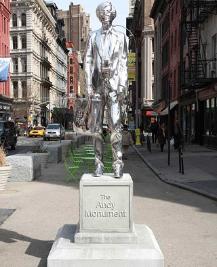Period Band C
Mirrors and Screens: The World of Andy Warhol
Tutor: James Boaden
Description
This module will look at Andy Warhol, one of the most influential artists of the latter half of the twentieth century – both artist and work are instantly recognizable to many people who have never stepped into a gallery. This course will seek to unsettle the fixed idea of Warhol’s life and work and find new inroads into the work itself and the critical literature that surrounds it. We will examine works from throughout the artist’s career including early illustrative pieces, his famous silkscreens, the rarely seen films, his magazine Interview, his autobiographical books and his work as a producer of The Velvet Underground. We will look at the effect of adopting mass production methods to the making of art, and the interplay with popular culture. We will examine a number of themes within the work such as violence, celebrity, mourning and consumerism.
This work will necessitate reading literature from fields outside of traditional art history including film studies, critical theory, cultural studies, and queer theory. Warhol’s work will be seen in the context of that of his contemporaries– particular attention will be paid to Jasper Johns, Robert Rauschenberg, Roy Lichtenstein, James Rosenquist, Le Monte Young, John Cage, Jean-Michel Basquiat, and Keith Haring amongst others. We will also examine the artist’s influence on a number of contemporary artists including Elizabeth Peyton, Damien Hirst, Takashi Murakami, Jeff Koons and Wang Guangyi. Seminars will vary from presentations, discussion of texts and screenings and exhibition visits.
Objectives
By the end of the module, students should:
- be able to address the work of Andy Warhol in relation to that of his artistic peers and the broader socio-historical situation in which it was created
- be able to think critically about the uses of biography and anecdotal histories for looking at artists’ production and the reception of their work
- have acquired knowledge of the techniques used in making Andy Warhol’s work
- be able to account for the influence of Warhol’s work in that of a number of contemporary artists
- have acquired familiarity with a range of critical, historical and analytical texts dealing with postmodernism
Preliminary Reading
- Annette Michelson (ed.), Andy Warhol, October Files no. 2, MIT Press, 2001 (if you buy one book – buy this one)
- Andy Warhol and Pat Hackett, Popism: The Warhol Sixties, Penguin, 2007 (lots of earlier editions)
- Andy Warhol, The Philosophy of Andy Warhol: From A to B and Back Again, Penguin, 2007 (lots of other editions since 1975)
- Bradford Collins, Pop Art, London 2012
- Thomas Crow, The Rise of the Sixties: American and European Art in the Age of Dissent, Everyman, (1996), 2005
- Steven Madoff (ed), Pop Art: A Critical History, California Press, 1996
- Lucy Lippard, Pop Art, Thames and Hudson, 1967
- Paul Schimmel et al, Hand Painted Pop: American Art in Transition: 1955-1962, Los Angeles Museum of Contemporary Art, 1992.
- William H Chafe, The Unfinished Journey: America Since World War Two, Oxford University Press, (1986)
The following novels will also be useful to your understanding of the course material:
- J.G Ballard, Crash, Harper Perennial, (1973), 2008
- Anthony Burgess, A Clockwork Orange, Penguin, 1962
- Don Delillo, White Noise, Picador, (1986), 2006
- Leopold Von Sacher Masoch, Venus in Furs, Penguin, (1870), 2000
If you can see these films please do:
- Factory Girl (dir. George Hickenlooper), 2006
- Basquiat (dir. Julian Schnabel), 1996
- I Shot Andy Warhol (dir. Mary Harron), 1996
- Paris is Burning (dir. Jennie Livingston), 1990
- Midnight Cowboy (dir. John Schlesinger), 1969

Module Code HOA00014H
